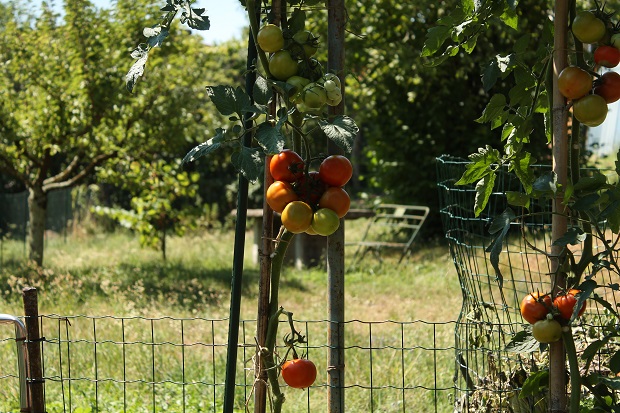Coffee grounds are a rich source of nitrogen.
Nitrogen supports strong and healthy leaf growth, which is essential for photosynthesis – the process by which plants convert sunlight into energy.
If we don’t supply enough nitrogen to our tomato plants, they can’t produce the energy needed to bear fruit.
Are coffee grounds good for tomato plants? The simple answer is yes.
So next time when you’re about to discard those used coffee grounds after brewing your morning cup o’ joe, remember they can be an excellent supplement for your tomato plants!
Suggested Reading: Are Coffee Grounds Good for Pepper Plants?
Table of Contents
Understanding the Nutritional Needs of Tomato Plants
Tomatoes, like any other plant, have particular nutritional needs that should be met for them to thrive. They’re heavy feeders and need more nutrients compared to some plants you might have in your garden.
Three primary nutrients are crucial for tomatoes:
- Nitrogen (N)
- Phosphorus (P)
- Potassium (K)
Nitrogen is essential for leaf growth, while phosphorus helps with flowering and fruiting. Potassium enhances the overall health of the plant, supporting functions such as photosynthesis.
| Nitrogen (N) | Leaf Growth |
| Phosphorus (P) | Flowering & Fruiting |
| Potassium (K) | Overall Plant Health |
Alongside these major players, tomatoes also require secondary nutrients including calcium, magnesium, and sulfur.
Additionally, they need micronutrients like boron, copper, iron among others.
Here’s how these nutrient-rich components look:
| Nitrogen | 2% |
| Calcium | <1% |
| Magnesium | <1% |
| Potassium | <1% |
Bear in mind though that while these nutrients certainly offer benefits to soil quality and plant health, they aren’t immediately available to plants upon application of the coffee grounds.
Now another thing worth mentioning here is acidity levels since many believe used coffee grounds are acidic – perfect for acid-loving tomatoes right?
Not quite! Used coffee grounds are actually near neutral with pH values generally ranging from 6.5 to 6.8 on average.
Suggested Reading: Are Coffee Grounds Good for Grass?

Are Coffee Grounds Beneficial for Tomato Plants?
In summary, yes! Let
Coffee grinds can be good news for tomato growers (and your tomato seedlings) – when used correctly – and can perk up not only our mornings but also our gardens!
As we have learned above, nitrogen contributes to leaf growth and development, which in turn supports photosynthesis – the process through which plants convert sunlight into energy for growth.
On average, fresh grounds contain about 2% nitrogen by volume.
Now compare this with garden soils that typically have a nitrogen content of less than 1%. That means incorporating coffee grounds into your soil can significantly boost its nitrogen levels and become a trusted fertilizer for tomato plants.
But that’s not all! Coffee grounds also improve soil structure, fertility, and enhance tomato plant growth.
Coffee Grounds on Tomato Plants help:
- Loosen compacted soil and improve its drainage.
- Attract beneficial earthworms to your garden.
- Their organic matter enriches the soil as it breaks down over time.
- May be able to prevent diseases in tomato plants.
However, before you start dumping your morning brew waste onto your tomatoes, take note of this important caution:
Coffee grounds can lower the pH level of your soil making it more acidic.
Tomato plants prefer slightly acidic to neutral pH levels (6.0 – 7.0), so too much coffee ground could potentially harm them
How to Use Coffee Grounds in Your Tomato Garden
NB: remove your coffee filters before adding the grinds to your soil.
Here’s how to use daily coffee grounds in your tomato garden:
- Composting: Incorporate used coffee grounds into your compost pile or bin if you have one. This enriches the compost with nutrients and aids decomposition.
- Direct Application (but lightly): If you prefer a more hands-on approach, sprinkle a thin layer of spent coffee grounds around the base of your tomato plants every two weeks or so.
- Making ‘Coffee’ for Your Plants: No kidding! Brew up a weak ‘coffee’ using spent grounds and water – about 6 cups of water to half a cup of used coffee grounds should do it. Strain this mix and use it to water your plants once every couple of weeks.
Just remember moderation is key here – too much caffeine can actually stunt plant growth.
For those of us who want to ensure their beloved veggies are safe: you can always test the pH level of your soil before adding anything new to ensure there won’t be any unpleasant surprises down the line. But this is not an essential step.
Read more about the best coffee machines on the market.
Potential Risks and Downsides of Using Coffee Grounds
While we’ve established that coffee grounds can provide some benefits to tomato plants, it’s important not to overlook the potential risks and downsides associated with their use.
Let me break down some key points of concern.
Firstly, coffee grounds are notably acidic. While tomatoes usually thrive in slightly acidic soil, an overabundance of acidity from excessive coffee grounds could jeopardize your plant’s health. I’ve seen instances where too much acidity has led to yellowing leaves—a clear sign of plant distress.
Secondly, if you’re spreading coffee grounds directly onto the soil surface without composting them first, they can form a crusty layer that hinders water penetration. This may leave your plants thirsty even after watering sessions.
Thirdly, fresh coffee grounds contain caffeine which is known for its antibacterial and herbicidal properties. Now while this might sound like a plus point at first glance (who doesn’t want pest-free plants?), these same properties can inhibit beneficial microorganisms in the soil needed for tomato growth.
Lastly but certainly not least, remember that:
- Coffee grounds are rich in nitrogen but lack significant amounts of phosphorus and potassium—essential nutrients for blossoming and fruit production.
- Over-reliance on coffee ground as a single source of nutrient could lead to imbalanced nutrition for your tomato plants.
As with any other aspect of gardening or life itself—it’s all about balance!
Alternative Organic Fertilizers for Tomato Plants
Coffee grounds are not the only organic fertilizer you can use.
Here are other eco-friendly options that might just give your tomato plants the boost they need.
Compost
Compost is one of the most popular alternatives to coffee grounds. It’s rich in nutrients and serves as an excellent soil conditioner.
With compost, your tomatoes won’t just survive—they’ll thrive! You can make this yourself by composting kitchen scraps and yard waste, or buy it from local garden centers.
Bone Meal
Next up on our list is bone meal—an excellent source of phosphorus which is crucial for root development and fruiting in tomato plants.
Besides phosphorus, it also contains calcium, another vital nutrient for healthy tomatoes.
In addition to these options, there are other natural fertilizers like alfalfa meal or cottonseed meal which provide a slow-release of nitrogen, essential for leafy growth, and other useful minerals.
Fish Emulsions or Seaweed Extracts
Last but certainly worth mentioning are fish emulsions or seaweed extracts. These marine-based fertilizers offer a balanced mix of nutrients including micronutrients often lacking in terrestrial fertilizers.
All these organic alternatives have their own unique benefits so don’t be afraid to experiment until you find what works best for your tomatoes!

Expert Opinions on Using Coffee Grounds as Fertilizer
Garden and soil specialists often agree that used coffee grounds can be beneficial for plants.
Their nutrients provide plants with what they need to grow and flourish.
Dr. Linda Chalker-Scott from Washington State University Extension wrote an article about using coffee grounds in gardens and landscapes. She said:
“Coffee grounds encourage the growth of microorganisms in the soil which use nitrogen for their growth and reproduction.”
However, she also cautioned against using them directly onto your plants due their acidity levels.
Several other experts have voiced similar opinions about coffee ground acidity affecting the PH level of soil. It’s recommended to compost your coffee grounds first or balance them with some lime or wood ash before mixing into your garden soil.
Now let’s shift our focus specifically to tomato plants – they generally prefer slightly acidic soil with pH levels ranging from 6.0 to 6.8 according to Cornell University’s home gardening guidelines.
Given all these expert opinions and research findings, it seems reasonable to conclude that used coffee grounds could be beneficial for your tomato plants when used correctly – meaning composted first or balanced properly with other materials.
Remember though: moderation is key! Too many coffee grounds can lead to excessive amounts of certain elements like caffeine which might affect plant growth negatively.
I hope this information helps you make an informed decision about whether or not using coffee grounds as fertilizer is right for your garden!
Conclusion: The Verdict on Coffee Grounds and Tomato Plants
The benefits of coffee grounds used on tomato plants are real.
Remember, coffee grounds are rich in nitrogen – a nutrient tomatoes crave. This added boost can help your tomato plants grow strong and healthy.
However, it’s essential to note that coffee grounds shouldn’t be the sole source of nutrients for your tomatoes. Make sure you’re still providing them with a balanced diet.
hose spent coffee grounds can improve soil structure, provide a solid boost of nitrogen and fertility over time by increasing its organic matter content. Improved soil health consequently leads to healthier plant growth.
Lastly, adding coffee grounds to your garden may deter certain pests like slugs and snails from munching on your precious tomatoes due to caffeine’s natural repelling properties.
But before you start dumping all your used coffee grounds onto your tomato plants, bear these points in mind:
- Balance is key: Overdoing it could lead to overly acidic soil which isn’t ideal for most tomato varieties.
- Composting first is best: Freshly used coffee grounds are quite acidic while composted ones are more neutral.
- Be mindful of other plants: While tomatoes might love the extra nitrogen boost, other nearby greens might not appreciate it as much.
So there we have it! Your morning ritual doesn’t have to end with sipping down that last drop of brew; you can also give back to nature by recycling those spent beans into something beneficial for our beloved red fruit – the humble tomato!
Just remember moderation is key when using any form of organic material as fertilizer – even seemingly harmless ones like coffee.
Further Reading:
Aeropress Instructions: My Guide to Making the Perfect Cup of Coffee
Stovetop Coffee: Mastering the Art of Traditional Brewing at Home
Chemex Coffee: Unveiling the Art and Science Behind Your Perfect Brew
